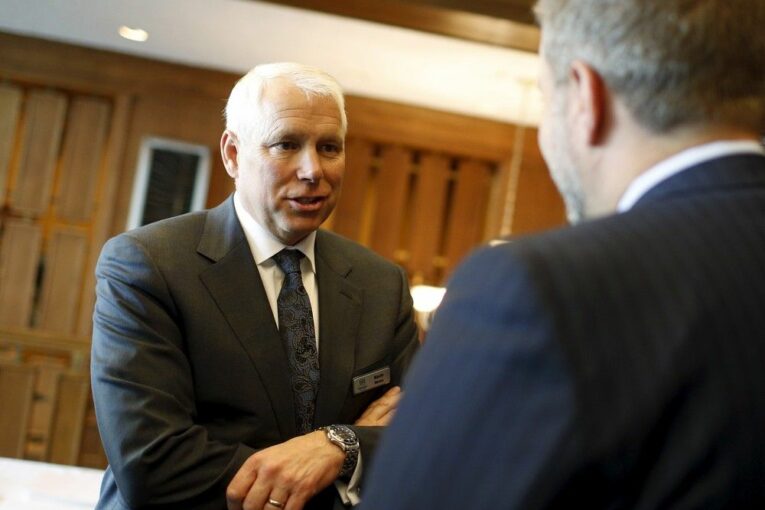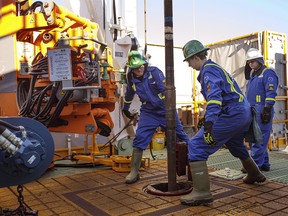
Precision Drilling Corp. ended last year on a high note, announcing Thursday that drilling activity increased 27 per cent during the final three months of 2022 — and continues to rise in January — while the company exceeded its own debt-repayment target.
One of the country’s largest drillers, Precision now employs 5,600 workers across the world, up about 25 per cent from a year ago.
As it looks to hire people needed to drill and maintain wells, the company — along with the country’s oilfield services industry — also faces a labour challenge: federal talk about “just transition” legislation to help oil and gas workers shift into other sectors.
“The energy transition is a great political headline. It’s going to take decades, not years, decades,” Precision Drilling CEO Kevin Neveu said in an interview.
“The tone of some of the charismatic political leaders . . . does not encourage new entrants into the workforce. So, we’ve had to combat that by aggressively marketing our Evergreen (environmental) products, and the things we’re doing to be part of the solution. But it does mean extra costs, extra resources.”
On Thursday, Precision Drilling announced it paid down $106 million of total debt in 2022, topping its earlier target for the year of $75 million.
The company also indicated the winter drilling season is heating up. It now has 78 rigs working across Western Canada, eclipsing last year’s peak of 72.
Neveu expects the company’s rig count will reach about 80 within the coming weeks and stressed the industry is focused on a “disciplined rebound,” unlike some of the past boom-bust cycles.
The oilfield services industry has regained its footing after a long downturn last decade and a painful period of layoffs. It was also pounded by the pandemic and a collapse in oil prices, which saw petroleum producers slash budgets almost three years ago.
However, activity levels have been coming back during the past year as both oil and gas prices have taken off.
By mid-December, the number of rigs working in Canada was up about 35 per cent from a year earlier, according to the Canadian Association of Energy Contractors (CAOEC).
The group forecasts more than 6,400 oil and gas wells will be drilled this year, a 15 per cent bump from 2022, leading to an additional 5,400 jobs in the industry.
“The big challenge, and what is going to really prohibit additional growth beyond 15 per cent, is just the staffing challenges,” CAOEC president Mark Scholz said Thursday.
BMO Capital Markets analyst John Gibson expects petroleum producers will increase capital expenditures by about 10 per cent this year over 2022 levels, even with oil and gas prices dropping recently.
“During COVID, people were worried about all these companies going under, and now the outlook for all their balance sheets is extremely strong, especially as we get into the end of this year,” he said.
Yet, one of the continuing issues confronting the industry is finding enough workers, as thousands of people left the sector over the past decade.
By November, the oil and gas industry employed about 188,500 Canadians, up 1.3 per cent — or 2,500 positions — from the same time a year earlier, according to the PetroLMI division of Energy Safety Canada.

During the same period, the industry’s total labour force shrank by 1.5 per cent.
While jobs are available, prospective employees worry about the industry’s longer-term future in an era of decarbonization.
Federal Natural Resources Minister Jonathan Wilkinson told CBC this week that the Liberal government will proceed with its planned just transition legislation early this year, an effort designed to help workers pivot to new jobs in a low-carbon economy.
“I am actually quite worried that there are so many opportunities . . . we will not have enough workers to fill the jobs,” Wilkinson told CBC.
An energy transition is occurring, yet it will take many, many years for the shift to unfold. In the meantime, workers are needed now in the oil and gas sector.
“It doesn’t help when we keep hearing ‘just transition’ and that automatically goes to being understood as we’re transitioning away from oil and gas and there are no jobs to be had, which is not the case,” said Gurpreet Lail, CEO of Enserva, formerly known as the Petroleum Services Association of Canada.
“The reality of the matter is you need jobs in oil and gas today to transform into any other form of energy, otherwise that is not going to happen.”
Scholz points out a transition is already happening, with many workers who drill for oil or gas also using their skills in areas such as geothermal, helium and lithium extraction.
And discussions about transitioning oilpatch workers, along with other signals being sent by Ottawa about the future of the energy sector, aren’t helping, say provincial leaders.
“This is not their jurisdiction,” Alberta Energy Minister Peter Guthrie said in a statement.
“If they are saying they have a ‘transition plan’ for our oil and gas workers, that means they are essentially saying, ‘We will be phasing out your oil and gas industry.’ This is unacceptable.”
Recommended from Editorial
-

Varcoe: Oilpatch spending grows on back of $100 crude, but labour shortages prevent rapid growth
-

Help Wanted: Alberta’s oil and gas industry struggling for entry-level workers during boom
-

‘It is your new normal’: Canada’s aging work force root of national labour shortage
Neveu pointed out the drilling industry is making strides to lower its emissions. The sector can likely meet federal targets with technology that already exists today, although it will require capital investment and time.
“Likely every worker in the industry today could probably retire from this industry in 20 or 30 years and complete their career here — if we manage this and balance both the environmental issues with the security of energy,” he added.
“It means we have to work harder to combat that messaging. It just frustrates me that we have a company strategy and company resources and company costs tied to combating federal government narratives.”
Chris Varcoe is a Calgary Herald columnist.
You can read more of the news on source
